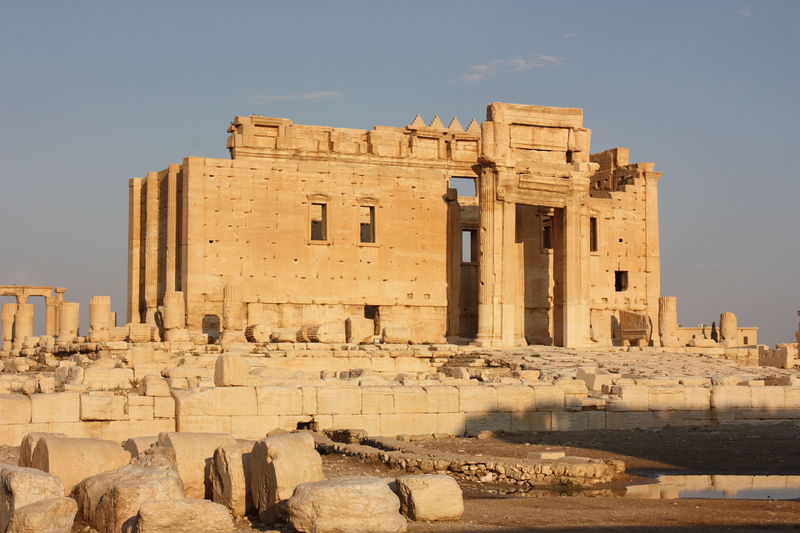The final launch of the Allmultimedia.org will take place on February 24, 2026
(shortly after the 2026 Winter Olympics).
Dovolená : 23. prosinec 2025 — 29. prosinec 2025
Holidays : December 23, 2025 — December 29, 2025
Soubor:Palmyra, Temple of Bel, from north-west-Flickr-2009.jpg
Z Multimediaexpo.cz

Velikost tohoto náhledu je: 800 × 533 pixelů
Obrázek ve vyšším rozlišení (rozměr: 4 272 × 2 848 pixelů, velikost souboru: 4,37 MB, MIME typ: image/jpeg)
Fotografie + English: Palmyra, Temple of Bel (Taken on May 11, 2009, Canon EOS 450D)
- Palmyra, Temple of Bel, from north-west
- Palmyra is an ancient Semitic city in present-day Homs Governorate, Syria. Archaeological finds date back to the Neolithic period and the city was first documented in the early second millennium BC. Palmyra changed hands between the different empires that ruled the area, becoming a subject of the Roman Empire in the first century AD.
Palmyra's wealth enabled the construction of monumental projects, such as the Great Colonnade, the Temple of Bel and the distinctive tower tombs. Palmyra grew wealthy from trade caravans; the Palmyrenes, renowned merchants, established colonies along the Silk Road and operated throughout the Roman Empire. The Palmyrenes were a mix of Amorites, Arameans and Arabs. The city's social structure was tribal, and its inhabitants spoke Palmyrene (a dialect of Aramaic); Greek was used for commercial and diplomatic purposes. The culture of Palmyra, influenced by Greco-Roman culture, produced distinctive art and architecture that combined eastern and western traditions. The city's inhabitants worshiped local deities and Mesopotamian and Arab gods.
By the third century AD, Palmyra was a prosperous regional center reaching the apex of its power in the 260s, when the Palmyrene king, Odaenathus defeated the Persian emperor Shapur I. The king was succeeded by the regent Queen Zenobia, who rebelled against Rome and established the Palmyrene Empire. In 273, the Roman emperor Aurelian destroyed the city, which was later restored by Diocletian, but at a reduced size. The Palmyrenes converted to Christianity during the fourth century and to Islam in the second half of the first millennium, after which the Palmyrene and Greek languages were replaced by Arabic.
Following its Roman destruction, Palmyra became a minor center under the Byzantines and later empires. Its destruction by the Timurids in 1400 reduced it to a small village. Under French Mandatory rule, in 1932, the inhabitants were moved into the new village of Tadmur and the ancient site became available for excavations.
The Temple of Bel, also known as the Temple of Baal, is an ancient temple located in Palmyra, Syria. The temple, consecrated to the Mesopotamian god Bel, worshipped at Palmyra in triad with the lunar god Aglibol and the sun god Yarhibol, formed the center of religious life in Palmyra and was dedicated in 32 AD. Its ruins are considered among the best preserved at Palmyra.
The temple was built on a tell with stratification indicating human occupation that goes back to the third millennium BC. The area was occupied in pre-Roman periods with a former temple that is usually referred to as "the first temple of Bel" and "the Hellenistic temple". The walls of the temenos and propylaea were constructed in the late first and the first half of the second century AD. The names of three Greeks who worked on the construction of the temple of Bel are known through inscriptions.
The Temple of Bel was converted into a Christian church during the Byzantine Era. Parts of the structure were modified by Arabs in 1132 which preserved the structure and converted the Temple into a mosque. Most of the Corinthian columns of the inner colonnades still show pedestals where the statues of the benefactors stood. The temple is aligned along the eastern end of the Great Colonnade at Palmyra.
- Author: Arian Zwegers
+ pochází z Flickr.com, kde má status – Creative Commons Attribution 2.0 Generic (CC BY 2.0)
FLICKR --- https://www.flickr.com/photos/azwegers/6362328227/
Historie souboru
Kliknutím na datum a čas se zobrazí tehdejší verze souboru.
| Datum a čas | Náhled | Rozměry | Uživatel | Komentář | |
|---|---|---|---|---|---|
| současná | 7. 3. 2017, 09:53 |  | 4 272×2 848 (4,37 MB) | Sysop (diskuse | příspěvky) | (Fotografie + + pochází z Flickr.com, kde má status – FLICKR --- Kategorie:CC fotografie ) |
- Editovat tento soubor v externím programu (Více informací najdete v nápovědě pro nastavení.)
Odkazy na soubor
Na soubor odkazuje tato stránka:
